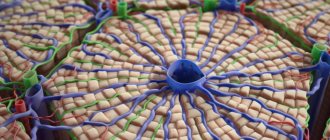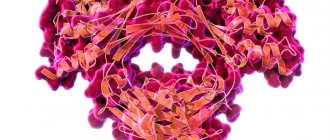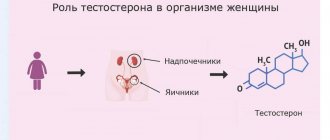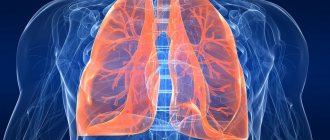Basophils are most often considered only as defenders against parasitic infections. However, scientists believe that their role in the body is much broader. Basophils play a role in allergic reactions, inflammation and autoimmune diseases. Read on to find out more about them.
The article is based on the findings of 63 scientific studies
The article quotes authors such as:
- Department of Microbiology, Perelman School of Medicine, University of Pennsylvania, USA
- Institut National de la Santé et de la Recherche Médicale, France
- National Institute of Allergy and Infectious Diseases, USA
Please note that the letters in brackets (1, 2, 3, etc.) are clickable links to peer-reviewed scientific studies. You can follow these links and read the original source of information for the article.
What are basophils?
Basophils are a type of circulating white blood cell in the bone marrow that are part of the white blood cells. Basophils circulate in the blood and can be recruited to peripheral tissues at sites of inflammatory foci. They protect the body and help it get rid of bacteria and parasites. Abnormal basophil levels are most often associated with allergies, asthma, and autoimmune diseases. (, )
Appearance of basophil
Basophils are the only circulating leukocytes that contain histamine , and they have much in common with their tissue resident counterparts, mast cells . Like mast cells, basophils are activated by antigen cross-linking of the Fc eRI -linked IgE receptor to undergo rapid degranulation and release their cellular contents.
Functions of basophils
The innate immune system (innate immunity) contains a set of mechanisms that allow the body to protect itself from harmful biomaterials (microorganisms, toxins, malignant cells, cells affected by viruses).
Basophils are part of the innate immune system because they can quickly respond to foreign organisms and substances. They are activated when they come into contact with foreign molecules, IgE immunoglobulin, or certain specific signals from other cells. (, , )
Classic pathophysiological process of allergic inflammation.
MS is a mast cell, the activation of which is supported by basophils .
(source) Most of the functions of basophils are associated with the release of heparin and histamine at the site of inflammation where they arrive. Basophils store heparin and histamine in special structures called granules. When these cells are activated, they release their granules. ()
Histamine dilates blood vessels and increases blood flow. Heparin is a well-known anticoagulant (reduces blood clotting). It also helps maintain proper blood flow. This allows all the necessary cells and substances to enter the site of inflammation from the bloodstream. (, )
Activated basophils are also a source of the cytokines IL-3 and IL-4. Scientists suspect that these molecules enhance the activity of both basophils themselves and other immune cells, potentially shifting the Th1/Th2 toward Th2 cells. (, , )
Basophils and mast cells have been implicated in the pathogenesis of allergic conditions because high levels of mediators common to both cell types are found in tissues implicated in allergic diseases. Basophils are also a source of the major Th2-driving cytokine , IL-4 , in the early stages of immune responses. Basophils are rapidly recruited to the skin, lungs, or nose following antigen challenge in humans, and are found in increased numbers in asthma, allergic rhinitis, atopic dermatitis, and nasal polyps. Thus, basophils may play a pathological role in both the onset and chronicity of allergic disease. ()
Normal basophil level
Laboratory test results are usually displayed as a set of values known as the “reference range,” which is sometimes called the “normal range.” The reference range includes the upper and lower limits of a laboratory test based on a large group of healthy people.
Basophils are the least numerous leukocytes. Their quantity is usually 0 – 0.20 x 10^9/l
(about 0.5% of the total number of leukocytes). ()
Remember that some interlaboratory variability occurs due to differences in equipment, methods, and chemicals used. Don't panic if your result is slightly out of range—as long as it's within the normal range based on the lab that did the testing, you should be considered normal.
However, it is important to remember that a routine test does not mean that a specific disease is absent. Your doctor will interpret your results in combination with your medical history and other test results.
Mast cells
Major populations of human mast cells
Mature mast cells are most often found in the skin, lymphoid organs, thymus, lungs, uterus, gastrointestinal tract, bladder, conjunctiva, nasal mucosa, synovial membranes, mesentery. Based on the presence of tryptase (trypsin-like protease) and chymase (chymotrypsin-like protease) in cells, two subpopulations (see table above):
- mast cells containing both enzymes (TKTX; present in the skin, intestinal submucosa and connective tissue);
- mast cells containing only tryptase (TKT; predominantly localized in the lungs and gastrointestinal tract).
These groups also have functional differences, although data on this are still rather scarce.
Enzyme double-positive skin cells are capable, unlike lung and intestinal cells containing only tryptase, to easily release histamine (read the link for what it is) in response to a wide range of different stimuli. The noted subpopulations also differ in the content of cytokines. For example, IL-4 is found primarily in TKTX, and IL-5 and IL-6 are expressed primarily in TKT. At the same time, both subpopulations of cells carry the FcεRI receptor on their surface and participate in IgE-dependent allergic and antiparasitic reactions.
Basophil activation assay
The basophil activation test is a blood test that evaluates the degree of basophil activation caused by an allergen. Doctors can use it to diagnose allergies to various substances, such as foods, medications or dust particles, pollen. ()
The interaction
of basophils and mast cells during an allergic reaction and the substances they secrete.
(source) During the test, a specific allergen is added to whole blood, where it can activate basophils. Activated basophils have specific molecules on their membrane (CD63 or CD203c) that help recognize them. However, there are some medications (such as omalizumab) that can interfere with the results of these tests. Therefore, you should warn in advance that you are taking such medications. (, , , )
When is it necessary to determine basophils in the blood?
A blood test to determine the level of basophils is carried out:
- during routine medical examinations;
- during examination before hospitalization for surgery;
- for the purpose of diagnosing infectious diseases, inflammatory phenomena, blood pathologies;
- to monitor the correctness of treatment.
The results are interpreted within the limits of the leukocyte formula; blood is not taken separately for basophils in laboratories.
Based on the level of this type of leukocyte, the doctor receives information about the presence/absence of an inflammatory process, the occurrence of allergic reactions, and may suspect a malignant blood disease. The result must be interpreted by a doctor: hematologist, infectious disease specialist, internist or pediatrician.
Increased level of basophils
Increased level of basophils
(
above 0.20 x 109/l
) is called
basophilia
. With a high degree of probability, such an increase is associated with the development of autoimmune inflammation or allergies. ()
Additionally, in one study of 47 patients with chronic myeloid leukemia, high basophil levels were associated with worse survival prognosis. ()
Causes of elevated basophil levels
Underactive thyroid gland
High levels of basophils may occur in people with hypothyroidism (underactive thyroid). ()
Myeloproliferative disorders in the bone marrow
Myeloproliferative disorders cause the bone marrow to produce too many white blood cells, red blood cells, or platelets. In rare cases, such changes can progress to leukemia.
Leukemia is a type of bone marrow cancer. This disease results in large numbers of abnormal white blood cells in the blood, including basophils. Basophilia is an important marker of leukemia. (, , )
Allergic reactions
Allergies are most often associated with inflammation, which is caused by activated basophils. When interacting with an allergen, basophils are activated, release their granules and contribute to the manifestation of allergy symptoms. ()
Inflammatory diseases
Ulcerative colitis and Crohn's disease
Ulcerative colitis and Crohn's disease are different inflammatory bowel diseases, but they share some common features.
While ulcerative colitis is allergic in nature, Crohn's disease is an autoimmune disease. However, both are associated with inflammation, which increases the number of basophils. ()
Rheumatoid arthritis
Rheumatoid arthritis is an autoimmune disease that causes inflammation of the joints. Juvenile rheumatoid arthritis is usually associated with increased levels of circulating basophils. However, adults with rheumatoid arthritis may have decreased levels of basophils. (, )
Asthma
Asthma is a serious inflammatory and allergic disease. It begins with the body's increased reactivity to common inhalant allergens. This disease is known for its “flares,” which lead to shortness of breath and coughing. ()
are thought to play a large role in the development of asthma , but their levels in the blood are usually within the normal range.
The inflammation of the lungs that causes asthma is associated with the secretion of interleukin-4 (IL-4) from immune cells called
basophils .
(source) It is important to note that patients with allergic asthma are sensitive to basophil levels, and studies show that elevated basophils indicate an impending attack. (, )
Infections
Bacterial, viral and parasitic infections can increase the number of basophils, for example tuberculosis, influenza, smallpox. Parasites in the human body produce many substances that can provoke immunity. Basophils play a critical role in this type of immune response. They also help the body respond more quickly to similar infections in the future. (, , )
Reasons for low level
A condition in which basophils are low is called basopenia. At the same time, their level drops below 0.01X10⁹ per liter. The reasons for low basophils may be the following:
- Acute infectious diseases.
- Acute pneumonia.
- Severe stress.
- Itsenko-Cushing syndrome.
- Hyperfunction of the thyroid gland.
- Pregnancy.
- Taking certain medications.
- Consequences of chemotherapy.
- The relative indicator is low during the recovery period for infectious diseases.
Any deviations in basophil levels should not be left without medical attention.
If estrogens are able to enhance the process of basophil formation, then glucocorticosteroids and another female hormone, progesterone, on the contrary, reduce their level. You can read about the reasons for the increase in basophils in this article.
Reduced basophil levels
Low levels of basophils are known as basopenia . Basopenia itself is not dangerous to your health, but it can be associated with certain medical conditions. (, , )
Basophils can penetrate from the blood into areas of inflammation. This migration reduces their circulating amount in the blood . (, )
When basophils release their granules, they are no longer active. These “empty” cells are not included in the basophil count during the analysis. (, )
When a low level of basophils is associated with their migration to areas of inflammation, this can serve as an additional argument for doctors when making a diagnosis. ()
Causes of reduced basophil levels
Overactive thyroid gland
Low basophil levels may occur in people with hyperthyroidism or being treated with thyroid hormones. ()
Hives
Hives are a type of skin rash with red and raised bumps called blisters. They are very itchy and itchy. This condition is usually caused by an infection or an allergic reaction. ()
Urticaria is caused by active molecules released by basophils and mast cells . Basophils migrate from the blood into urticaria blisters during disease activity, thereby causing basopenia (a decrease in the number of basophils circulating in the blood). (, , )
Lupus
Lupus (systemic lupus erythematosus) is an autoimmune disease in which the immune system attacks healthy tissue. It causes inflammation in various parts of the body (such as joints, skin, heart and brain). ()
The inflammatory process in lupus causes the accumulation of basophils in secondary lymphatic organs , such as the lymph nodes, tonsils and spleen, which leads to a decrease in the level of basophils in the blood. (, )
Schematic representation of exacerbation of systemic lupus erythematosus (SLE) by the production of basophil activation-dependent autoantibodies and interleukin IL-17. (source)
Taking corticosteroids
Corticosteroids reduce both the activity of basophils and their number. If you take corticosteroids, your basophil levels may be reduced. Talk to your doctor about possible problems you may have while receiving corticosteroids. (, )
Other diseases
Anxious depression
One study of 709 participants linked anxious depression to decreased levels of basophils in the blood. The authors showed a link between inflammation and depression, although no causal conclusions could be drawn. Other multidirectional studies are needed to obtain a more precise relationship. ()
Smoking
Smoking activates basophils and decreases the level of intact basophils. Therefore, smoking can theoretically lead to the development of basopenia. However, studies have produced mixed results. One study of 498 people found basophilia (an increase in basophils) in smokers. (, , )
Factors influencing basophil activity
You may try the additional steps listed below if you and your doctor decide they may be appropriate. None of these options should ever be used in place of what your doctor recommends or prescribes.
The following additional approaches are supported only by limited clinical research. There is not enough evidence to support their use in people with high basophil counts.
In a study of 44 patients, crocin
(20 mg) reduced the amount of basophil by almost 15%.
Although crocin is a compound from saffron , saffron itself is quite ineffective when used long-term. Large-scale clinical studies are needed. (, )
Saffron and its components protect the brain.
Saffron has a number of medicinal properties, such as antihypertensive, hypolipidemic, antitussive, antidepressant, anticonvulsant, anxiolytic, antioxidant, antitumor, antinociceptive and anti-inflammatory effects. (source) In a human study of 20 patients, Polygoni Cuspidatum extract had anti-inflammatory properties. In mice, it suppressed the SYK signaling pathway, present in both mast cells and basophils. This reduced the release of histamine and the production of allergic cytokines. (, )
Some studies on humans and animals have shown that tiny particles and various substances in polluted air increase the activity of basophils. (, , )
Chronic stress negatively affects the body in many ways. It increases levels of the hormones cortisol and norepinephrine, which has negative consequences for the immune system. Scientists believe that cortisol stimulates the Th2 type of immune cells, and that norepinephrine increases the activity of basophils . (, , , , )
Limited evidence suggests that exposure to antibiotics is associated with a higher risk of developing asthma. There is an assumption that this is due to incorrect reactions of basophils. However, this relationship may be indirect or inconsistent and remains unproven. (, , )
EVEN MORE USEFUL INFORMATION
Allergies - Survival Tips
Histamine: food and other stimuli to increase it










